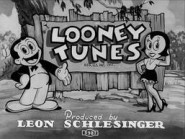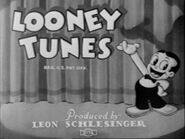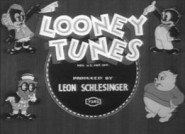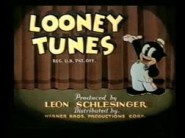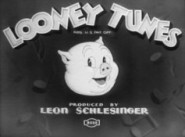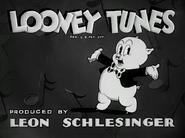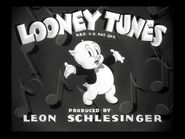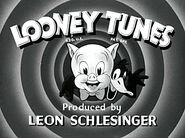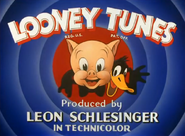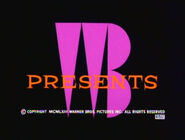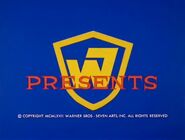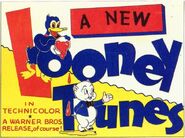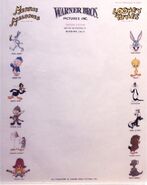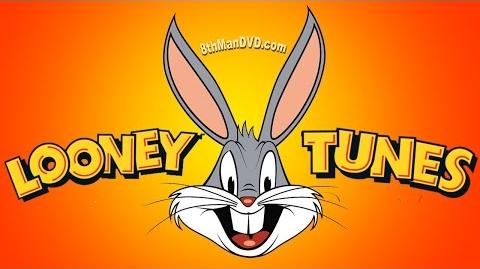Template:Infobox SeriesLooney Tunes is a Warner Bros. series of animated short films. It was produced from 1930 to 1969 during the Golden Age of American Animation, alongside its sister series Merrie Melodies.[1] Looney Tunes originally showcased Warner-owned musical compositions through the adventures of cartoon characters such as Bosko and Buddy. Later Looney Tunes films featured such popular cartoon stars as Bugs Bunny, Daffy Duck, Porky Pig, Elmer Fudd, Tweety, Sylvester, Granny, Yosemite Sam, Foghorn Leghorn, Marvin the Martian, Pepé Le Pew, Witch Hazel, Speedy Gonzales, the Tasmanian Devil, Wile E. Coyote and the Road Runner. These characters themselves are commonly referred to as the "Looney Tunes" (or "Looney Toons").
The names Looney Tunes and Merrie Melodies are both parodies of Silly Symphonies, the name of Walt Disney's concurrent series of music-based short films. From 1942 into the 1960s, Looney Tunes and Merrie Melodies were the most popular cartoon shorts in movie theaters, exceeding the works of Disney and other popular competitors; including Paramount Pictures (Popeye the Sailor), Universal Pictures (Woody Woodpecker) and MGM (Tom and Jerry, Droopy, etc.).[2]
Since its success during the short film era of cartoons, Looney Tunes has become a worldwide media franchise; spawning several television series, feature films, comic books, music albums, video games, and amusement park rides. Many of the characters have made and continue to make cameo appearances in various other television shows, films, and advertisements.
The most famous Looney Tunes character, Bugs Bunny, is regarded as a cultural icon and has appeared in more films than any other cartoon character.[3] Several Looney Tunes films are regarded as some of the greatest animated cartoons of all time.[4]
History

The First Looney Tunes Title

In the beginning, both Looney Tunes and Merrie Melodies drew their storylines from Warner's vast music library. From 1934 to 1943, Merrie Melodies were produced in color and Looney Tunes in black and white. Some Looney Tunes series were produced in color for a test experiment from 1942-1943. After 1943, however, both series were produced in color and became virtually indistinguishable, with the only stylistic difference being in the variation between the opening theme music and titles. Both series also made use of the various Warner Bros. cartoon characters. By 1937, the theme music for Looney Tunes was "The Merry-Go-Round Broke Down" by Cliff Friend and Dave Franklin; the theme music for Merrie Melodies was an adaptation of "Merrily We Roll Along" by Charles Tobias, Murray Mencher, and Eddie Cantor.
1930-1969
In 1929, to compete against Walt Disney's Mickey Mouse short cartoons, WB became interested in developing a series of musical animated shorts to promote their music. They had recently acquired the ownership of Brunswick Records along with four music publishers for US $28 million. Consequently, they were eager to start promoting this material to cash in on the sales of sheet music and phonograph records. Warner made a deal with Leon Schlesinger to produce cartoons for WB. Schlesinger hired Hugh Harman and Rudolf Ising to produce their first series of cartoons. Bosko was the first major Looney Tunes lead character, debuting in the short "Bosko, The Talk-Ink Kid" in 1929. The first Looney Tunes short was "Sinkin' in the Bathtub", which was released in 1930.[1]

From 1937–1939, and from 1939-1946, every Looney Tune (except for two) ended with Porky Pig coming out of a drum and saying "th-th-th-that's all folks!" The reason the years are split was because Porky was redesigned for the newer drum ending.

Color version of the closing drum featuring Porky Pig in 1945
When Harman and Ising left Warner Bros. in 1933 over a budget dispute with Schlesinger, they took with them all the rights of the characters and cartoons which they had created. A new character called Buddy became the only star of the Looney Tunes series for a couple of years. New directors including Tex Avery, Friz Freleng, and Bob Clampett were brought in to work with animators in the Termite Terrace studio. In 1935 they debuted the first truly major Looney Tunes star, Porky Pig, along with Beans in the Merrie Melodie cartoon "I Haven't Got a Hat" directed by Friz Freleng. Beans was the star of the next Porky/Beans cartoon "Gold Diggers of '49", but it was Porky who emerged as the star instead of Beans. The ensemble characters of "I Haven't Got a Hat", such as Oliver Owl, and twin dogs Ham and Ex, were also given a sampling of shorts, but demand for these characters was far exceeded by Beans and Porky; Beans himself was later phased out due to declining popularity, leaving Porky as the only star of the Schlesinger studio. This was soon followed by the debuts of other memorable Looney Tunes stars; Daffy Duck (in 1937's "Porky's Duck Hunt"), Elmer Fudd (in 1940's "Elmer's Candid Camera"), and Bugs Bunny (in 1940's "A Wild Hare").
Bugs initially starred in the color Merrie Melodies shorts and formally joined the Looney Tunes series with the release of "Buckaroo Bugs" in 1944, which is the final cartoon produced by Leon Schlesinger. Schlesinger began to phase in the production of color Looney Tunes with "The Hep Cat". The final black-and-white Looney Tunes short was "Puss n' Booty" in 1943, directed by Frank Tashlin. The inspiration for the changeover was Warner's decision to re-release only the color cartoons in the Blue Ribbon Classics series of Merrie Melodies. Bugs made a cameo appearance in 1942 in the Avery/Clampett cartoon "Crazy Cruise" and also at the end of the Frank Tashlin 1943 cartoon "Porky Pig's Feat" which marked Bugs' only appearance in a black-and-white Looney Tunes short. Schlesinger sold his interest in the cartoon studio in 1944 to Warner Bros. and went into retirement; he would die 5 years later in 1949.
The original Looney Tunes theatrical series ran from 1930 to 1969 (the last short being "Injun Trouble", by Robert McKimson).[1] During part of the 1960s, the shorts were produced by DePatie-Freleng Enterprises after Warner Bros. shut down their animation studios. The shorts from this era can be identified by their different title sequence, featuring stylized limited animation and graphics on a black background and a new arrangement, by William Lava, of "The Merry-Go-Round Broke Down." The change in the introductory title cards was possibly to reflect the switch in the animation style of the shorts themselves.
1970-1999
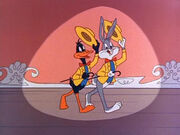
Bugs Bunny and Daffy Duck in the intro to The Bugs Bunny Show, which ran on network television from 1960-2000.
The Looney Tunes series' popularity was strengthened even more when the shorts began airing on network and syndicated television in the 1950s under various titles and formats. However, since the syndicated shorts' target audience was children and because of concerns over children's television in the 1970s, the Looney Tunes shorts were edited, removing scenes of violence (particularly suicidal gags and scenes of characters doing dangerous stunts that impressionable viewers could easily imitate), racial and ethnic caricatures (particularly stereotypical portrayals of blacks, Mexicans, Jews, American Indians, Asians, and Germans as Nazis), and questionable vices (such as smoking cigarettes, ingesting pills, and drinking alcohol).
Theatrical animated shorts went dormant until 1987 when new shorts were made to introduce Looney Tunes to a new generation of audiences. New Looney Tunes shorts have been produced and released sporadically for theaters since then, usually as promotional tie-ins with various family movies produced by Warner Bros. While many of them have been released in limited releases theatrically for Academy Award consideration, only a few have gotten theatrical releases with movies. The most recently released Looney Tunes short was "Daffy's Rhapsody" in 2012, shown theatrically with Journey 2: The Mysterious Island.
In the 1970s through the early 1990s, several feature-film compilations and television specials were produced, mostly centering on Bugs Bunny and/or Daffy Duck, with a mixture of new and old footage. In 1976, the Looney Tunes characters made their way into the amusement business when they became the mascots for the two Marriott's Great America theme parks (Gurnee, Santa Clara). After the Gurnee park was sold to Six Flags, they also claimed the rights to use the characters at the other Six Flags parks, which they continue to do presently. In 1988, several Looney Tunes characters appeared in cameo roles in Touchstone, Disney, and Amblin's Oscar-winning epic Who Framed Roger Rabbit. The more notable cameos featured Bugs Bunny, Daffy Duck, Porky Pig, Yosemite Sam, Sylvester, and Tweety. It is the only time in which Looney Tunes characters have shared screen time with their rivals at Disney (producers of the film)—particularly in the scenes where Bugs and Mickey Mouse are skydiving, and when Daffy and Donald Duck are performing their "Dueling Pianos" sequence.
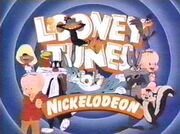
One of the logos for Looney Tunes on Nickelodeon.
In 1988, Nickelodeon aired all the unaired cartoons in a show called Looney Tunes on Nickelodeon until 1999. To date, Looney Tunes on Nickelodeon is the longest-airing animated series on the network that was not a Nicktoon (although Nickelodeon doesn't air Looney Tunes anymore). In 1996, Space Jam, a feature film mixing animation and live-action, was released to theaters starring Bugs Bunny and Michael Jordan. Despite its odd plot and mixed critical reception,[5] the film was a major box-office success, grossing nearly $100 million in the U.S. alone, almost becoming the first non-Disney animated film to achieve that feat.[6] For a two-year period, it was the highest grossing non-Disney animated film ever.[7] The film also introduced Lola Bunny, who subsequently became another recurring member of the Looney Tunes, usually as a love interest for Bugs.
The Looney Tunes characters have also had success in the area of television, with appearances in several originally produced series, including Taz-Mania (1991, starring the Tasmanian Devil) and The Sylvester & Tweety Mysteries (1995, starring Sylvester, Tweety, and Granny). The gang also made frequent cameos in Tiny Toon Adventures, from executive producer Steven Spielberg where they played teachers and mentors to a younger generation of cartoon characters (Buster Bunny, Babs Bunny, Plucky Duck, etc.), plus occasional cameo appearances in the later Warner Bros. shows Animaniacs (also from Spielberg) and Histeria!.
2000-present
In 2000, WB decided to make the Looney Tunes and Merrie Melodies library exclusive to fellow Time Warner properties, specifically Cartoon Network. Immediately prior to this decision, Looney Tunes shorts were airing on several networks at once: On Cartoon Network, on Nickelodeon (as Looney Tunes on Nickelodeon), and on ABC (as The Bugs Bunny and Tweety Show). The latter two had been particularly long-running series, and the Warner Bros. decision forced the two networks to cancel the programs. In 2003, another feature film was released, this time in an attempt to recapture the spirit of the original shorts: The live-action / animated Looney Tunes: Back in Action. Although the film wasn't financially successful,[8] it was met with relatively positive reviews from film critics and has been argued by animation historians and fans as the finest original feature-length appearance for the cartoon characters.[9][10][11]
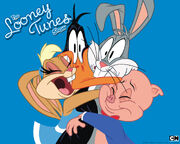
Lola, Daffy, Bugs and Porky in a promotional image for The Looney Tunes Show on Cartoon Network
In 2006, Warner Home Video released a new, Christmas-themed Looney Tunes direct-to-video film titled Bah, Humduck! A Looney Tunes Christmas featuring a wide array of characters working in a mega-store under the Scrooge-esque Daffy Duck. The film parodies the famous book by Charles Dickens A Christmas Carol. Other Looney Tunes TV series included Baby Looney Tunes (2002, which had a similar premise to Muppet Babies), Duck Dodgers (2003, starring Daffy Duck, Porky Pig, and Marvin the Martian), and Loonatics Unleashed, (2005, featuring futuristic versions of the characters). Most recently, the characters have appeared on the Cartoon Network sitcom The Looney Tunes Show (2011, featuring Bugs and Daffy living in the suburbs with their fellow castmates) and Wabbit: A Looney Tunes Prod. (2015, featuring Bugs returning to his slapstick comedy roots).
Although the classic cartoon shorts are seldom seen in USA television programming, thanks to revival theatrical screenings, and the Golden Collection DVD box sets, Looney Tunes and its characters has remained a part of Western animation heritage.
Controversy
Stereotypes
A handful of Looney Tunes and Merrie Melodies shorts from the 1930s-40s are no longer aired on USA television, (some not on sale) because of the racial stereotypes of African-Americans, Jews (especially in the earlier cartoons, despite the fact that all four of the Warner brothers that the studio was named for were Jewish as well[12]), Japanese, Chinese, and Germans (especially during WWII, as in "Tokio Jokio") included in some of the cartoons.[13] Eleven cartoons that prominently featured stereotypical black characters (and a few passing jokes about Japanese people, as was the case with "Coal Black and de Sebben Dwarfs" and "Jungle Jitters") were withdrawn from distribution in 1968 and are known as the Censored Eleven. This has caused dismay among some animation enthusiasts, who feel they should have access to these shorts. There has been some success in returning these cartoons to the public.
In 1999 all Speedy Gonzales cartoons were made unavailable because of their alleged stereotyping of Mexicans.[14] When many Hispanics protested that they were not offended, and fondly remembered Speedy Gonzales cartoons as a representation of their youth and nation's individuality, these shorts were made available for broadcast again in 2002.[15] but because the level of stereotyping was minor compared to the World War II era cartoons, as well as the protests of many Hispanics who said they were not offended and fondly remembered Speedy Gonzales cartoons from their youth, these shorts were made available for broadcast again in 2002. This would be short lived, however, as Cartoon Network and Boomerang ceased airing Speedy Gonzales (as well as the Warner Bros. cartoons in general) for a while (however, the shorts (still majorly excluding Speedy) eventually returned full time after many random appearances in 2011).
In addition to these most notorious cartoons, many Warner cartoons contain fleeting or sometimes extended gags that reference then-common racial or ethnic stereotypes. The release of the Looney Tunes Golden Collection: Volume 3 includes a disclaimer at the beginning of each DVD in the volume given by actress Whoopi Goldberg which explains that the cartoons are products of their time and contain racial and ethnic stereotypes that these days would be considered offensive, but the cartoons are going to be presented on the DVD uncut and uncensored because editing them out and therefore denying that the stereotypes existed is almost as bad as condoning them.
A written disclaimer, similar to the words spoken by Goldberg in Volume 3, is shown at the beginning of each DVD in the Looney Tunes Golden Collection: Volume 4 and Volume 5 sets:
- "The cartoons you are about to see are products of their time. They may depict some of the ethnic and racial prejudices that were commonplace in the U.S. society. These depictions were wrong then and they are wrong today. While the following does not represent the Warner Bros. view of today's society, these cartoons are being presented as they were originally created, because to do otherwise would be the same as claiming that these prejudices never existed."
Censorship
|
This article/section is a stub. You can help Looney Tunes Wiki by expanding it. |

|
A variety of Looney Tunes and its sister series Merrie Melodies have had scenes cut out from television to remove stereotyping or violent gags.[16]
United States
Throughout the years, the censorship varies, but most of the time violent gags tend to be much more heavily edited back in the 1970s and 1980s on the TV networks such as ABC and CBS, probably due to stricter rules against violence in children's TV back during the 1970s and 1980s, in comparison to today where most of the violent gags are shown uncut (with the notable exceptions of suicide gags involving guns) on TV channels such as Cartoon Network.
However, seldom are these affected cartoons are present in their original forms when shown on television, primarily outside of the USA are they present uncensored.
United Kingdom
When Boomerang UK re-branded and started broacasting in 16:9 HD in 2015, the Looney Tunes shorts began to be shown heavily edited (much like Tom and Jerry which was shown on the same network); the violence, jokes, alcohol and smoking from these shorts are removed from the channel.
Arab/Middle East countries
Several Looney Tunes shorts have been edited in these countries due to risque content which is considered objectionable by Islam religion, e.g. the striptease scene from "The Wise Quacking Duck" and a short scene from "Bugs Bunny Rides Again" featuring swimsuit-clad women in a train coach named 'MIAMI SPECIAL' were all cut from Cartoon Network Arab for this reason.
Dubbed versions
- Main article: Dubbed Versions
Colorization
In 1967, the Warner Bros.-Seven Arts company reissued 78 of the black-and-white Looney Tunes in a primitive colorization process. The duplicate Guild/Sunset prints were sent to South Korea where artists re-traced each cartoon frame-by-frame in color. The quality dropped considerably with the hand-colored versions, to the point where some animation sometimes, could not be carried over.
These cartoons continued to be seen over the decades, and even some of the hand-colored cartoons ended up on low-budget bargain-bin home video labels (the hand-colored versions were copyrighted, but it has been suggested they too have fallen into the public domain).
Between 1990-1995, Warner Bros. released the same 78 black-and-white shorts again in color (plus 26 cartoons which were not colorized in 1967), but this time, using a digital colorization process rather than re-coloring them frame-by-frame as in 1967. The digital technology allowed for the quality of the original animation to be preserved; thus, these colorized versions could be seen as superior to the 1967 versions.
Networks today like Boomerang USA still continue to show the hand-colorized and computer-colorized versions. However, today, the Sunset/Guild and pre-1948 cartoons are seldom aired, rather today, the USA networks air more of the cartoons released between 1948-69.
In the 1980s, Turner/MGM asked for some of their 1931-33 Merrie Melodies cartoons to be hand-colorized. While this newer colorization was better quality than the 1970s Sunset/Guild coloring system, it was never as good as the 1990-95 CPU colorizing system.
Changes in copyright owners
In the 1950s, WB sold their copyrights to various companies to earn money to continue their studio productions. Needless to say, the various new owners neglected the renewal of their cartoons, forcing them to enter the public domain in the USA. In addition, WB neglected or forgot to renew copyright on some of their black and white cartoons.
Ownership Sunset/Guild Films
In 1955, Warner Bros. sold distribution rights to the black-and-white Looney Tunes (plus the first Merrie Melodie, "Lady, Play Your Mandolin!", and the B&W Merrie Melodies made after Harman and Ising left) to Sunset Productions/Guild Films. WB created duplicate prints that were inferior to the original negatives and gave it to Guild. However, WB kept the original negatives and also wanted that the opening and closing titles be changed to remove all references to Warner Bros., even to the point where "Porky in Wackyland" was severly edited to remove many references of WB, including the WB sign in the cartoon. The cartoons were distributed by Guild Films until it was sold to Motion Pictures for Television closing Guild in 1961.
When Guild shut down in 1961, Motion Pictures retained the rights for a brief amount of time before closing when merging with Seven Arts Productions. In 1967, Seven Arts merged with Warner Bros. to create Warner Bros.-Seven Arts thus putting those films back in Warner's ownership.[17]
All the while, starting in 1967, Warner Bros. was able to retain the rights to "Lady Play Your Mandolin" and the black-and-white Looney Tunes, even though the pre-1933 shorts ended up in the public domain because of Guild Films neglect to renew most of the copyrights. By the time Guild shut down in 1961, Motion Pictures for Television renewed the copyrights for the Buddy and black and white Merrie Melodies cartoons. However, when WB regained rights to the cartoons, they too, neglected their copyrights and it forced the cartoons to fall into the public domain in the USA and majority of these public domain shorts have been released on many low-budget independent home video labels. As of 1996, all WB's animated output (including the post-'48 shorts WB also kept) are under the same Time Warner umbrella of ownership.
Ownership Associated Artists Productions and future companies
In 1956, Associated Artists Productions (a.a.p. or AAP) bought the copyrights for most of Warner Bros.' pre-1950[18][19] library, including all Merrie Melodies (except for those sold to Sunset) and color Looney Tunes (the six 1942-43 color shorts also had their copyrights given to AAP. By the time they were given back to WB in 1996, three of them were already in the public domain.) shorts that were released prior to August 1948. Warner Bros. also sold the copyrights of their Monogram Films and other silent and pre-1950 films to them as well. However, WB prepared 8mm and 16mm duplicate prints, like the sale of Guild, to distribute on TV. These were inferior to what was being shown at the movie theatres and overtime these 8mm and 16mm prints were even duplicated into much more inferior prints causing many currently unavailable on DVD cartoons to have various qualities around the Internet. WB retained their original negatives at the studios, however, they failed to send new batches of prints every ten years, unlike the post-1948 cartoons and the Guild package, which had new transfers made every ten years to make them appear marketable. The old prints were then junked.
Unlike the sale to Sunset Productions, a.a.p. was allowed to keep the Warner titles intact and simply inserted an "Associated Artists Productions presents" title at the head of each reel so each Merrie Melodie cartoon had the song "Merrily We Roll Along" playing one time plus the first half of the song while each Looney Tune had the LT theme plus the first half of the MM theme.[20] a.a.p. later went bankrupt and shut down a second time, this time for good. United Aritsts bought their assets and paid their way out of bankruptcy and merged the company into its television division—United Artists Television. United Aritsts even removed the Censored Eleven from USA television packages in 1968 due to severe stereotyping of black people. They continued however, to show the rest of the pre-1948 output.
In 1981, UA was sold to MGM. Metro-Goldwyn-Mayer renamed themselves MGM/UA. Pretty soon they started to release pre-1948 cartoons on their first home video set called the Viddy-Oh! For Kids Cartoon Festivals. These prints were also to what was being shown in the movie theaters because WB never send MGM new prints of the cartoons. In addition to the inferiority, the prints even had altered opening titles, using the Farm Frolics Blue Ribbon titles. A few years later, Ted Turner acquired the MGM library—which also included U.S. rights to the RKO Pictures library, in addition to MGM's pre-1986 material, the classic Warner Bros. library, and some of UA's own product, in an attempt to take over MGM. By the time all the assets of MGM were gone, except some of United Artist's assets, MGM/UA released a second VHS series called Cartoon Moviestars. These new home video releases had the correct opening titles, unlike the previous. Turner's company, Turner Broadcasting System (whose Turner Entertainment division oversaw the film library), merged with Time Warner in 1996, thus the classic library was once again under ownership of WB (although technically they are owned by Turner, with WB handling sales and distribution).
MGM/UA and Turner (under the pre-WB / Turner-merger management of MGM/UA Home Video) officially released numerous compilations of the classic pre-8/48 cartoons on VHS and LaserDisc, most of these under the title The Golden Age of Looney Tunes. Today, Warner Home Video holds the video rights to the entire Looney Tunes/Merrie Melodies animated output by virtue of WB's ownership of Turner Entertainment, which is why there are both pre-1948 films and post-1948 films on the DVD/Blu-Ray sets.
Quality of prints used for television and video
When the Looney Tunes were shown on TV, WB prepared 16mm "dupes" in Eastmancolor of the original prints for the syndication market; these prints faded over time, causing them to look "inferior" to what was being shown at the movies. WB failed to send new prints to AAP and its successors over the years and meanwhile, the post-1948 cartoons new prints were created periodically to continue appearing fresh, including their 1998 dubbed versions. a.a.p. and its successor companies (Turner, MGM/UA) never had any access to WB's original negatives.
As a result, when the cartoons entered local syndication, there would be considerable difference in quality of the WB-owned and a.a.p./UA/MGM/Turner-owned shorts. The former package had new prints prepared for the cable networks that aired them, whereas the latter package, when shown on the Turner networks, looked inferior, faded, and dull, even after two separate remasters in 1987 and 1995. For MGM, this was a problem even on the official video releases in the VHS/laserdisc era prior to 1999 because MGM only had access to the prints WB sent them, and WB never made new prints for MGM to release on home video.
When Time Warner and Turner Entertainment had merged in 1996, the a.a.p. package cartoons were released on VHS and later as DVD/Blu-Ray bonuses using their USA 1995 dubbed versions. These were master dubbed copies, unlike the TV 1995 copies used. Meanwhile, a handful, and only those listed on the Dubbed Versions page, of post-1948 cartoons were remastered in 1997 and 1998 for TV airings and a selection of European VHS/DVD videos, which looked far superior to the 1995 dubbed versions.
The recent Looney Tunes DVD & Blu-Ray sets are all derived from the original negatives, restored to pristine condition, with some minor scratches, creating an experience similar to when the shorts were first shown in theaters although, the Looney Tunes Platinum Collection restorations have a bit darker hue than the Golden Collection set. However, only about a third of all the LT/MM library are available restored. The other two-thirds are still unrestored, with WB having low sales of recent sets and no more budget left to restore these leftover shorts.
"That's all Folks!"
"That's all Folks!" is a coined phrase that has appeared in nearly every Looney Tunes and Merrie Melodies short film to date. Originally, when the Merrie Melodies series started, it used the phrase "So long Folks!" to distinguish itself from Looney Tunes, but eventually adopted "That's all Folks!" as well. Characters such as Bosko (1930-1933), Buddy (1933-1935), and, for the most part, Porky Pig (1937-1946), had had the job of ending cartoons with this phrase.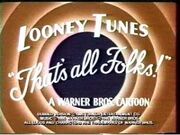
The phrase as it appears at the end of a USA Turner Dubbed version transfer of a cartoon. From the faded quality, this was most likely recorded on a VHS.
Accolades
NOTE: "LT" stands for Looney Tunes; "MM" for Merrie Melodies.
Shorts selected into the National Film Registry:
- What's Opera, Doc? (MM; 1957), selected in 1992
- Duck Amuck (MM; 1953), selected in 1999
- Porky in Wackyland (LT; 1938), selected in 2000
- One Froggy Evening (MM; 1955), selected in 2003
Academy Awards for Best Short Subject (Animation):
- Tweetie Pie (MM; 1947)
- For Scent-imental Reasons (LT; 1949)
- Speedy Gonzales (MM; 1955)
- Birds Anonymous (MM; 1957)
- Knighty Knight Bugs (LT; 1958)
Academy Award nominations:
- It's Got Me Again! (MM; 1932)
- Detouring America (MM; 1939)
- A Wild Hare (MM; 1940)
- Hiawatha's Rabbit Hunt (MM; 1941)
- Rhapsody in Rivets (MM; 1941)
- Pigs in a Polka (MM; 1943)
- Greetings Bait (LT; 1943)
- Swooner Crooner (LT: 1944)
- Life with Feathers (MM; 945)
- Walky Talky Hawky (LT; 1946)
- Mouse Wreckers (LT; 1948)
- From A to Z-Z-Z (LT; 1954)
- Sandy Claws (LT; 1954)
- Tabasco Road (LT; 1957)
- Mexicali Shmoes (LT; 1959)
- Mouse and Garden (LT; 1960)
- High Note (LT; 1960)
- Beep Prepared (MM; 1961)
- Nelly's Folly (MM; 1962)
- Now Hear This (LT; 1963)
See also
- Merrie Melodies
- Looney Tunes and Merrie Melodies filmography
- Looney Tunes Golden Collection
- The Bugs Bunny Show
- Tiny Toon Adventures
- Taz-Mania
- The Sylvester & Tweety Mysteries
- Space Jam
- Looney Tunes: Back in Action
- Baby Looney Tunes
- Duck Dodgers
- Loonatics Unleashed
- The Looney Tunes Show
- New Looney Tunes
- Looney Tunes Cartoons
- Charles Jones
- Friz Freleng
- Fred Avery
- Robert Clampett
- Robert McKimson
- Mel Blanc
- June Foray
Gallery
Promotional material
Videos
References
- ↑ 1.0 1.1 1.2 "Looney Tunes". www.bcdb.com, April 12, 2012
- ↑ Warner Bros. Studio biography. AnimationUSA.com. Retrieved on July 22, 2008.
- ↑ Most Portrayed Character in Film at Guinness World Records; retrieved 2011-11-23.
- ↑ http://www.foxnews.com/entertainment/2013/09/24/greatest-cartoons-all-time-tv-guide-list/
- ↑ "Movie Reviews: Space Jam". Retrieved on January 23, 2008.
- ↑ Space Jam (1996). Box Office Mojo. Internet Movie Database. Retrieved on 2011-12-02.
- ↑ Beck, Jerry (2005). The Animated Movie Guide. Chicago, Illinois: Chicago Review Press.
- ↑ Looney Tunes: Back in Action. Boxofficemojo.com. Retrieved on January 25, 2008.
- ↑ Looney Tunes: Back in Action :: rogerebert.com :: Reviews. Rogerebert.suntimes.com. Retrieved on October 29, 2012.
- ↑ Rosenbaum, Jonathan (2003). Joe Dante Calls the Toon. Chicago Reader. Retrieved on January 25, 2008.
- ↑ Edelstein, David (November 14, 2003). Movie Review: Looney Tunes: Back in Action. Slate. slate.com. Retrieved on February 2, 2008.
- ↑ "The Warner Brothers: Albert, Harry, Jack, and Sam Warner". Retrieved on 2008-01-23.
- ↑ Error on call to template:cite web: Parameters archiveurl and archivedate must be both specified or both omitted"The Warner Brothers: Albert, Harry, Jack, and Sam Warner".. Retrieved on January 23, 2008.
- ↑ Speedy Gonzales Caged by Cartoon Network, www.foxnews.com, March 28, 2002
- ↑ Emling, Shelly. "Cartoon Network putting Mexican mouse back in the lineup", Milwaukee Journal Sentinel, June 21, 2002. Retrieved on November 6, 2010.
- ↑ http://www.intanibase.com/gac/looneytunes/censored.aspx
- ↑ geocities.com
- ↑ You Must Remember This: The Warner Bros. Story (2008), p. 255.
- ↑ WB retained a pair of features from 1949 that they merely distributed, and all short subjects released on or after September 1, 1948; in addition to all cartoons released in August 1948.
- ↑ geocities.com

